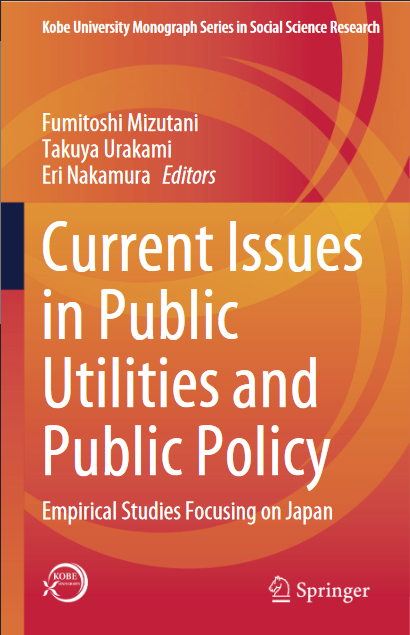18 F. Mizutani et al. 2.1 Introduction Since the Great East Japan Earthquake, the promotion of energy saving in not only industrial and commercial sectors, but also in the residential sector has become an important issue in the Japanese energy industry. One promising way to encourage consumers to save electricity is Demand Response1 (DR). Also, with society’s present pursuit of low-carbon energy goals, DR is attracting attention as a means of main- taining the stability of the power system during the massive transition to renewable energy, the supply of which is still unstable. DR can refer to many different schemes, which can generally be classified into Price-driven and Incentive-driven.2 First, typical price-driven demand responses include (a) Time of Use (TOU), (b) Critical Peak Pricing (CPP), (c) Real Time Pricing (RTP), (d) Critical Peak Pricing with Control, and (e) System Peak Transmission Tariff. With incentive-driven DR, the DR provider directly suppresses the electricity demand of consumers or makes use of the supply–demand adjustment market. A number of incentive-based DR schemes have been proposed using frameworks such as (a) Direct Load Control, (b) Load as Capacity Resource, (c) Emergency Demand Response, (d) Interruptible Load, and (e) Spinning Reserve. In addition, there is non-price-driven DR, designed to appeal to consumer morality. Falling into this category are non-legally enforceable power saving requests by power companies, for example after the Great East Japan Earthquake in 2011, when there was widespread cooperation among consumers to save electricity when requested to do so, regardless of cost-saving. Among these DR types, this paper focuses on Time Varying Pricing DR and non- legally enforceable electricity saving requests. Many empirical analyses have been carried out to investigate the extent to which these types of DR schemes, which take advantage of the characteristics of human behavior, can encourage household elec- tricity saving. A further compelling task is to analyze households’ heterogeneous reaction to Dynamic Pricing. It is important for policy makers to know empiri- cally to what extent DR can reduce households’ electricity consumption, how its effects differ depending on household attributes, and how feasible it would be to introduce. However, due to a lack of detailed household-level information, previous studies have been unable to examine the relationship sufficiently. The authors have obtained detailed data on household income, the daytime presence or absence of family members due to work or in-family caretaking, the number of air conditioners, the number of refrigerators, whether a house is all-electric, the size of the house, the 1 There are varying definitions of DR (see, for example, Eid et al. [7]). According to the Department of Energy [6], “DR is a program to motivate changes in electricity use by end-use customers, designed to induce lower electricity use typically at times of high market prices or when grid reliability is jeopardized.”. 2 Yan et al. [28] classifies DR into two categories: price-driven and incentive-driven DR. 2 An Analysis of the Effect of Demand Response on Electricity ... 19 age of the house, and total floor space. By utilizing highly detailed household infor- mation obtained from a randomized field experiment on demand response in Japan, this paper investigates how the effect of Time Varying Pricing DR varies according to household attributes. This paper consists of six sections. After the introduction, Sect. 2.2 describes previous literature. Section 2.3 explains data sources as well as the design of the field experiment data and introduces variables to be focused on. Section 2.4 explains empirical models as well as empirical strategy. Section 2.5 shows the empirical results and a discussion of findings relevant to policy formation. Section 2.6 summarizes major research findings and suggests topics for future studies
چکیده فارسی
18 F. Mizutani et al. 2.1 مقدمه از زمان زلزله بزرگ ژاپن شرقی، ترویج صرفه جویی در انرژی نه تنها در بخش های صنعتی و تجاری، بلکه در بخش مسکونی نیز به موضوع مهمی در صنعت انرژی ژاپن تبدیل شده است. یکی از راههای امیدوارکننده برای تشویق مصرفکنندگان به صرفهجویی در مصرف برق، پاسخ به تقاضا1 (DR) است. همچنین، با پیگیری فعلی جامعه برای اهداف انرژی کم کربن، DR به عنوان وسیله ای برای حفظ پایداری سیستم قدرت در طول انتقال گسترده به انرژی های تجدیدپذیر، که عرضه آن هنوز ناپایدار است، توجه را به خود جلب می کند. DR می تواند به بسیاری از طرح های مختلف اشاره داشته باشد که به طور کلی می توانند به دو دسته قیمت محور و انگیزه محور طبقه بندی شوند. 2 اول، پاسخ های تقاضای قیمت محور معمولی شامل (الف) زمان استفاده (TOU)، (ب) قیمت گذاری اوج بحرانی (CPP) است. )، (ج) قیمت گذاری در زمان واقعی (RTP)، (د) قیمت گذاری اوج بحرانی با کنترل، و (ه) تعرفه اوج انتقال سیستم. با DR مبتنی بر انگیزه، ارائهدهنده DR مستقیماً تقاضای برق مصرفکنندگان را سرکوب میکند یا از بازار تعدیل عرضه و تقاضا استفاده میکند. تعدادی از طرحهای DR مبتنی بر انگیزه با استفاده از چارچوبهایی مانند (الف) کنترل بار مستقیم، (ب) بار به عنوان منبع ظرفیت، (ج) پاسخ تقاضای اضطراری، (د) بار وقفهای، و (ه) ذخیره چرخشی پیشنهاد شدهاند. علاوه بر این، DR غیر قیمت محور وجود دارد که برای جلب نظر اخلاق مصرف کننده طراحی شده است. در این دسته قرار می گیرند درخواست های غیرقانونی صرفه جویی در مصرف برق توسط شرکت های برق، به عنوان مثال پس از زلزله بزرگ ژاپن شرقی در سال 2011، زمانی که همکاری گسترده ای بین مصرف کنندگان برای صرفه جویی در مصرف برق در صورت درخواست، صرف نظر از صرفه جویی در هزینه وجود داشت. در میان این انواع DR، این مقاله بر روی DR قیمتگذاری متغیر با زمان و درخواستهای صرفهجویی در مصرف برق غیرقانونی تمرکز دارد. تحلیلهای تجربی بسیاری برای بررسی میزانی که این نوع طرحهای DR، که از ویژگیهای رفتار انسانی بهره میبرند، میتوانند صرفهجویی در مصرف برق خانگی را تشویق کنند، انجام شده است. یک کار قانعکننده دیگر، تحلیل واکنش ناهمگن خانوارها به قیمتگذاری پویا است. برای سیاست گذاران مهم است که به طور تجربی بدانند که DR تا چه حد می تواند مصرف برق خانوارها را کاهش دهد، تأثیرات آن بسته به ویژگی های خانوار چگونه متفاوت است و معرفی آن چقدر امکان پذیر است. با این حال، به دلیل فقدان اطلاعات دقیق در سطح خانوار، مطالعات قبلی نتوانسته اند این رابطه را به اندازه کافی بررسی کنند. نویسندگان اطلاعات دقیقی در مورد درآمد خانوار، حضور یا عدم حضور اعضای خانواده در طول روز به دلیل کار یا مراقبت در خانواده، تعداد دستگاه های تهویه مطبوع، تعداد یخچال ها، اینکه آیا یک خانه تماما برقی است، اندازه تعاریف مختلفی از DR وجود دارد (برای مثال به عید و همکاران [7] مراجعه کنید). طبق گفته وزارت انرژی [6]، "DR برنامه ای برای ایجاد انگیزه در استفاده از برق توسط مشتریان نهایی است که برای القای مصرف کمتر برق معمولاً در زمان های قیمت های بالای بازار یا زمانی که قابلیت اطمینان شبکه به خطر می افتد، طراحی شده است." 2 یان و همکاران. [28] DR را به دو دسته طبقه بندی می کند: DR مبتنی بر قیمت و انگیزه محور. 2 تجزیه و تحلیل اثر پاسخ تقاضا بر برق ... 19 سن خانه، و فضای کل طبقه. با استفاده از اطلاعات بسیار دقیق خانوار به دست آمده از یک آزمایش میدانی تصادفی شده بر روی پاسخ تقاضا در ژاپن، این مقاله بررسی می کند که چگونه اثر زمان متغیر قیمت گذاری DR با توجه به ویژگی های خانوار متفاوت است. این مقاله از شش بخش تشکیل شده است. پس از مقدمه، بخش. 2.2 ادبیات قبلی را توصیف می کند. بخش 2.3 منابع داده و همچنین طراحی داده های آزمایش میدانی را توضیح می دهد و متغیرهایی را معرفی می کند که باید روی آنها تمرکز کرد. بخش 2.4 مدل های تجربی و همچنین استراتژی تجربی را توضیح می دهد. بخش 2.5 نتایج تجربی و بحث در مورد یافته های مربوط به شکل گیری سیاست را نشان می دهد. بخش 2.6 یافته های تحقیقات عمده را خلاصه می کند و موضوعاتی را برای مطالعات آینده پیشنهاد می کند
ادامه ...
بستن ...
Editors
Fumitoshi Mizutani
Graduate School of Business
Administration
Kobe Universtiy
Kobe, Japan
Eri Nakamura
Graduate School of Business
Administration
Kobe University
Kobe, Japan
Takuya Urakami
Faculty of Business Administration
Kindai University
Higashiosaka, Osaka, Japan
ISSN 2524-504X ISSN 2524-5058 (electronic)
Kobe University Monograph Series in Social Science Research
ISBN 978-981-19-7488-5 ISBN 978-981-19-7489-2 (eBook)
https://doi.org/10.1007/978-981-19-7489-2
© The Editor(s) (if applicable) and The Author(s), under exclusive license to Springer Nature
Singapore Pte Ltd. 2023
This work is subject to copyright. All rights are solely and exclusively licensed by the Publisher, whether
the whole or part of the material is concerned, specifically the rights of translation, reprinting, reuse
of illustrations, recitation, broadcasting, reproduction on microfilms or in any other physical way, and
transmission or information storage and retrieval, electronic adaptation, computer software, or by similar
or dissimilar methodology now known or hereafter developed.
The use of general descriptive names, registered names, trademarks, service marks, etc. in this publication
does not imply, even in the absence of a specific statement, that such names are exempt from the relevant
protective laws and regulations and therefore free for general use.
The publisher, the authors, and the editors are safe to assume that the advice and information in this book
are believed to be true and accurate at the date of publication. Neither the publisher nor the authors or
the editors give a warranty, expressed or implied, with respect to the material contained herein or for any
errors or omissions that may have been made. The publisher remains neutral with regard to jurisdictional
claims in published maps and institutional affiliations.
This Springer imprint is published by the registered company Springer Nature Singapore Pte Ltd.
The registered company address is: 152 Beach Road, #21-01/04 Gateway East, Singapore 189721,
Singapore
ادامه ...
بستن ...










